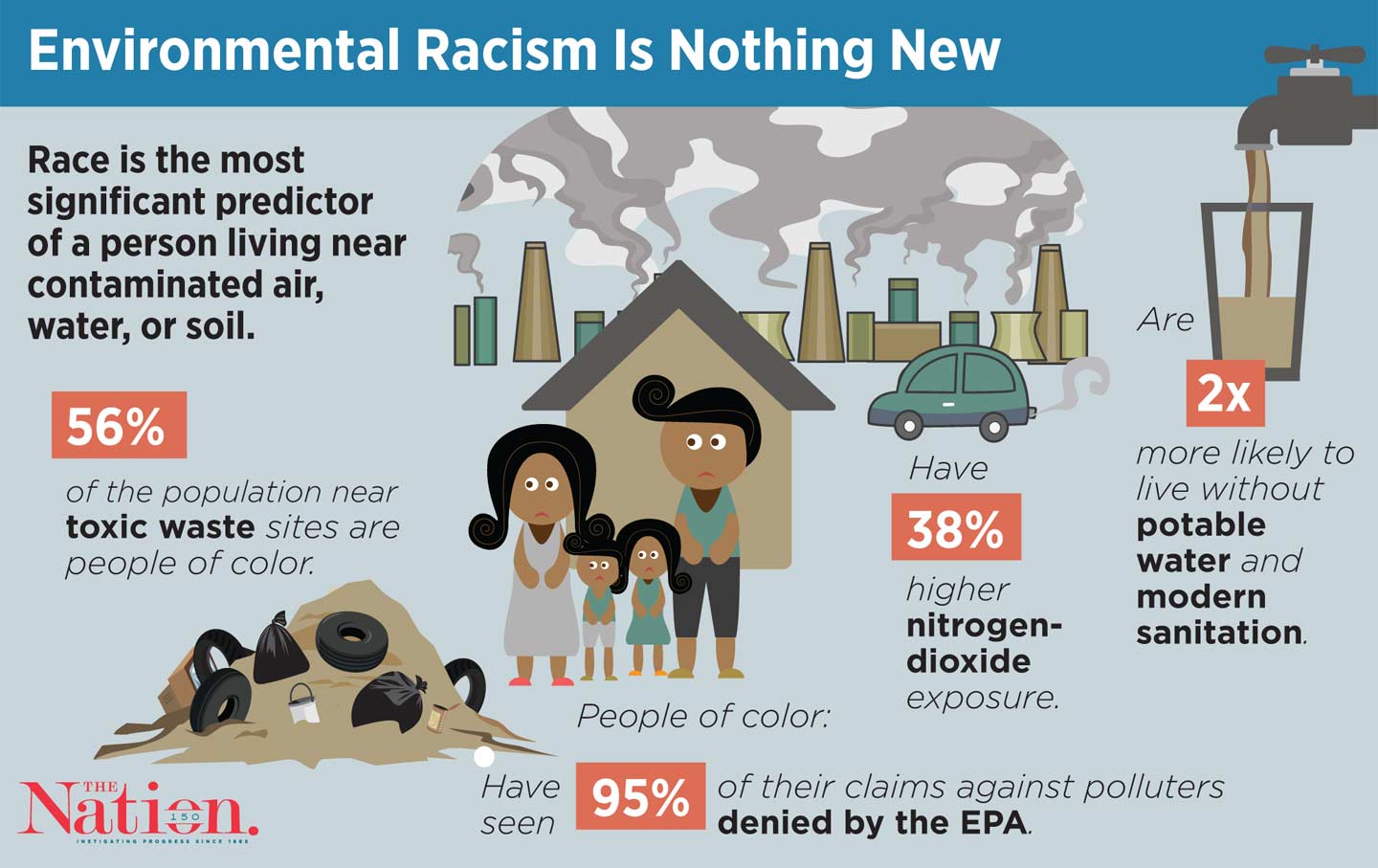
ACTION ALERT: Fight Environmental Racism; Demand Climate Justice
Petition to Congress: Pass the Climate Equity Act
WASHINGTON (November 7, 2019) — The Trump administration declared war on our climate on day one. Trump rolled back auto regulations, opened public lands to fossil-fuel polluters, sabotaged the EPA and just officially withdrew the United States from the Paris Climate Accord. (1)
But even the Trump administration admits environmental racism is real. A report from the Trump EPA shows that people of color are far more likely to live near polluted areas and to breathe polluted air. (2) It adds weight to what we already know: the worst effects of climate change land hardest on immigrants, communities of color, low-income communities and Indigenous peoples. (3)
Rep. Alexandria Ocasio-Cortez and Sen. Kamala Harris have a new bill – the Climate Equity Act — that would put fixing racial injustice at the heart of US climate policy. (4) The Climate Equity Act is one of the major planks of the Green New Deal, and we need to show massive support for it.
Every region of the United States is already experiencing the destructive effects of climate change. From record flooding to unprecedented wildfires to extreme weather, climate change is here today. Scientists tell us we have little more than a decade to prevent the most catastrophic climate scenarios. (5)
But climate change hits some communities harder than others. Low-income communities, communities of color, immigrants, indigenous peoples, rural Americans, the elderly, the unhoused and people with disabilities disproportionately feel the effects of climate change. Whether they live in low-lying areas, near sources of pollution or simply cannot guard against storms and wildfires, these communities are on the frontlines of climate change. Even the best environmental legislation in the past – like the Clean Air and Clean Water Acts – focuses on broad effects and ignores crucial instances of racism and environmental injustice. (6)
The Climate Equity Act, in contrast, centers the problems of frontline communities. It would mandate that all environmental legislation receive an equity score of its effects on different communities, force the executive branch to do extra investigation of policies that have a disparate impact on frontline communities and create special advisory roles so advocates and representatives from these communities have a seat at the table. (7)
Tackling environmental racism and creating climate equity is key to achieving true environmental justice. The Climate Equity Act will protect frontline communities – and we need to show every member of Congress just how much support it has.
ACTION: Tell Congress: Fight Environmental Racism. Pass the Climate Equity Act Now.
References:
- Katrina vanden Heuvel, “Trump’s greatest dereliction of duty — his disgraceful denial of climate change,” The Washington Post, Nov. 5, 2091.
- Vann R. Newkirk II, “Trump’s EPA Concludes Environmental Racism Is Real,” The Atlantic, Feb. 28, 2019.
- Sen. Kamala Harris, “The Climate Equity Act.”
- Ibid.
- Jonathan Watts, “We have 12 years to limit climate change catastrophe, warns UN,” The Guardian, Oct. 8, 2018.
- Sen. Kamala Harris, “The Climate Equity Act.”
- Ibid.
CREDO Action is a publication of Working Assets

Trump’s EPA Concludes Environmental Racism Is Real
A new report from the Environmental Protection Agency finds that people of color are much more likely to live near polluters and breathe polluted air—even as the agency seeks to roll back regulations on pollution.
Vann R. Newkirk II / The Atlantic
(February 28, 2018) — “Poison is the wind that blows from the north and south and east.” Marvin Gaye wasn’t an environmental scientist, but his 1971 single “Mercy Mercy Me (The Ecology)” provides a stark and useful environmental analysis, complete with warnings of overcrowding and climate change. The song doesn’t explicitly mention race, but its place in Gaye’s What’s Going Onalbum portrays a black Vietnam veteran, coming back to his segregated community and envisioning the hell that people endure.
“Poison is the wind that blows from the north and south and east.” Marvin Gaye wasn’t an environmental scientist, but his 1971 single “Mercy Mercy Me (The Ecology)” provides a stark and useful environmental analysis, complete with warnings of overcrowding and climate change. The song doesn’t explicitly mention race, but its place in Gaye’s What’s Going On album portrays a black Vietnam veteran, coming back to his segregated community and envisioning the hell that people endure.
The study focuses on particulate matter, a group of both natural and manmade microscopic suspensions of solids and liquids in the air that serve as air pollutants. Anthropogenic particulates include automobile fumes, smog, soot, oil smoke, ash, and construction dust, all of which have been linked to serious health problems.
Particulate matter was named a known definite carcinogen by the International Agency for Research on Cancer, and it’s been named by the EPA as a contributor to several lung conditions, heart attacks, and possible premature deaths. The pollutant has been implicated in both asthma prevalence and severity, low birth weights, and high blood pressure.
As the study details, previous works have also linked disproportionate exposure to particulate matter and America’s racial geography. A 2016 study in Environment International found that long-term exposure to the pollutant is associated with racial segregation, with more highly segregated areas suffering higher levels of exposure.
A 2012 article in Environmental Health Perspectivesfound that overall levels of particulate matter exposure for people of color were higher than those for white people. That article also provided a breakdown of just what kinds of particulate matter counts in the exposures. It found that while differences in overall particulate matter by race were significant, differences for some key particles were immense. For example, Hispanics faced rates of chlorine exposure that are more than double those of whites. Chronic chlorine inhalation is known for degrading cardiac function.
The conclusions from scientists at the National Center for Environmental Assessment not only confirm that body of research, but advance it in a top-rate public-health journal. They find that black people are exposed to about 1.5 times more particulate matter than white people, and that Hispanics had about 1.2 times the exposure of non-Hispanic whites.
The study found that people in poverty had about 1.3 times more exposure than people above poverty. Interestingly, it also finds that for black people, the proportion of exposure is only partly explained by the disproportionate geographic burden of polluting facilities, meaning the magnitude of emissions from individual factories appears to be higher in minority neighborhoods.
These findings join an ever-growing body of literature that has found that both polluters and pollution are often disproportionately located in communities of color. In some places, hydraulic-fracturing oil wells are more likely to be sited in those neighborhoods. Researchers have found the presence of benzene and other dangerous aromatic chemicals to be linked to race. Strong racial disparities are suspected in the prevalence of lead poisoning.
It seems that almost anywhere researchers look, there is more evidence of deep racial disparities in exposure to environmental hazards. In fact, the idea of environmental justice—or the degree to which people are treated equally and meaningfully involved in the creation of the human environment—was crystallized in the 1980s with the aid of a landmark study illustrating wide disparities in the siting of facilities for the disposal of hazardous waste.
Leaders in the environmental-justice movement have posited—in places as prestigious and rigorous as United Nations publications and numerous peer-reviewed journals—that environmental racism exists as the inverse of environmental justice, when environmental risks are allocated disproportionately along the lines of race, often without the input of the affected communities of color.
The idea of environmental racism is, like all mentions of racism in America, controversial. Even in the age of climate change, many people still view the environment mostly as a set of forces of nature, one that cannot favor or disfavor one group or another. And even those who recognize that the human sphere of influence shapes almost every molecule of the places in which humans live, from the climate to the weather to the air they breathe, are often loathe to concede that racism is a factor.
To many people, racism often connotes purposeful decisions by a master hand, and many see existing segregation as a self-sorting or poverty problem. Couldn’t the presence of landfills and factories in disproportionately black neighborhoods have more to do with the fact that black people tend to be disproportionately poor and thus live in less desirable neighborhoods?
But last week’s study throws more water on that increasingly tenuous line of thinking. While it lacks the kind of complex multivariate design that can really disentangle the exact effects of poverty and race, the finding that race has a stronger effect on exposure to pollutants than poverty indicates that something beyond just the concentration of poverty among black people and Latinos is at play.

As the study’s authors write: “A focus on poverty to the exclusion of race may be insufficient to meet the needs of all burdened populations.” Their finding that the magnitude of pollution seems to be higher in communities of color than the number of polluters suggests, indicates that regulations and business decisions are strongly dependent on whether people of color are around. In other words, they might be discriminatory.
This is a remarkable finding, and not only because it could provide one more policy linkage to any number of health disparities, from heart disease to asthma rates in black children that are double those of white children. But the study also stands as an implicit rebuke to the very administration that allowed its release.
Under the guidance of President Trump and Administrator Scott Pruitt, the EPA has begun to walk back already anemic federal environmental-justice work, putting a stop to some civil-rights investigations and replacing or firing many of the scientists with deep technical knowledge of the subject.
Last year, facing cuts to the environmental-justice program that seem likely to continue, former assistant associate administrator Mustafa Santiago Ali resigned. Further changes to move the offices of environmental justice into a policy office staffed by Pruitt hires promise to further reduce the autonomy of life-long environmental-justice staffers and reduce the effectiveness of their work.
More broadly, with a defiant stance against climate and environmental science, Trump and Pruitt have begun a rollback of environmental protections. Pruitt appears to be dismantling Clean Air Act provisions at every turn, and while Trump’s promises to save the coal industry have produced no real policy in his first year, there are still opportunities in 2018 and beyond. And while all these actions in the aggregate will likely increase the amount of particulate matter in the air for everyone, the White House’s own research shows what Marvin Gaye saw 47 years ago: The burden will be increased most on people of color.
Posted in accordance with Title 17, Section 107, US Code, for noncommercial, educational purposes